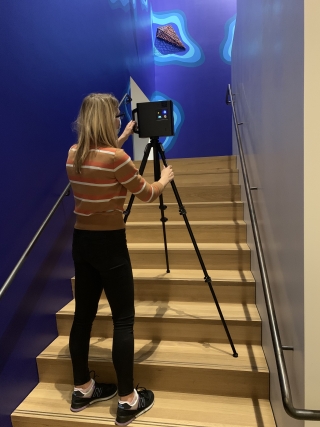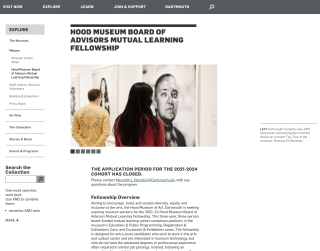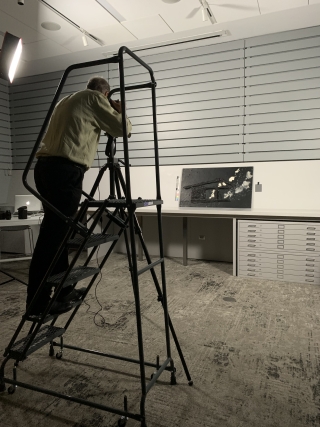
LEFT Screenshot of the Matterport 3D virtual tour of Form and Relation: Contemporary Native Ceramics.

Throughout this fiscal year, the Hood Museum of Art was able to take a long, hard look at our digital assets and take visionary steps toward enhancing visitor experience from near and afar, as well as support the institution from within.

ABOVE Digital Content Manager Alison Palizzolo captures Courtney Leonard's site specific installation in the stairway with the 3D camera. Photo by Jami Powell.
After the museum was forced to close its doors due to the pandemic in March 2020, a virtual exhibitions team was formed almost immediately. The team discussed and researched various platforms and ways to present virtual exhibitions to our audiences. A gift from Claire Foerster and Daniel Bernstein made it possible for the museum to purchase Matterport 3D-imaging equipment and software. Digital Content Manager Alison Palizzolo, Curator of Indigenous Art Jami Powell, and Digitization Technician Christopher Warren worked on the first test scans for the fall 2020 board meeting. After Form and Relation and Courtney's Leonard's site-specific installation were captured, Alison continued to work with the virtual exhibitions team to identify other spaces and exhibitions that would make successful 3D virtual tours. We also worked with Dartmouth's web services team to create a display for the Matterport tours on individual exhibition pages.
As of July 2021, the museum has published a total of five Matterport tours, including Orozco's Epic of American Civilization, the first rotation of A Legacy for Learning: The Jane and Raphael Bernstein Collection, and The Temple Murals: The Life of Malcolm X. Currently, the plan is to continue capturing selected exhibitions with the Matterport equipment, even after the pandemic has ended. Though the galleries opened to the public again in August 2021, we are excited to continue sharing exhibition content this way in order to broaden and better serve our audiences everywhere. This fall, the museum plans to launch Matterport tours of Drawing Lines and the second rotation of A Legacy for Learning.
These tours are also educational tools. The Matterport software allows us to add supplementary content such as wall labels, pdfs of publications, audio files, videos, etc. Interdepartmental collaboration and strategic thinking, particularly in terms of educational content, occurs when planning and creating these supplementary materials. For example, the Drawing Lines virtual tour includes video content intended to give the viewer a closer look at certain works, like Carolina Caycedo's Curative Mouth and Heather McGill's Spiral Galaxy.
As of July 2021, the museum's collection of published Matterport tours has been visited by 3,097 visitors. The tour of Orozco's mural cycle The Epic of American Civilization has been visited 1,751 times by 1,108 unique visitors; Form and Relation been visited 550 times by 407 unique visitors; Courtney Leonard's installation has been toured 300 times by 227 unique visitors; the first-round of installations presented in A Legacy for Learning have been visited 246 times by 174 unique visitors; and The Temple Murals has been visited 204 times by 154 unique visitors.

ABOVE Amelia Kahl, Barbara C. & Harvey P. Hood 1918 curator of academic programming, films a spotlight on Beverly Pepper's "Thel."
In late April 2021, the museum launched its blog Meanwhile at the Museum. The purpose is to provide our audiences with a behind-the-scenes look at the unseen museum. It is a platform on which a multitude of voices, across all areas of the museum, are heard. All posts are signed by individual authors or coauthors, eliminating the need for a single institutional or formal unified voice. The tone of the content is professional but written from a first-person point of view. This platform allows for a different type of storytelling, one that ideally generates deeper engagement with and investment from all our audiences. Posts are promoted across all our social media platforms and in the monthly e-newsletter, and are linked within the Explore menu on the museum's website.
Between the blog's launch in April and July 1, 2021, the museum published seven posts, has had 628 pageviews, over 393 sessions, by 250 unique users. Contributions have come from the registrar team, education, digital and archives, exhibition preparations, curatorial, and a Dartmouth student (and Hood Museum intern). Several posts also featured outside contributors, including a local schoolteacher, Dartmouth colleague from Digital Humanities, and a professor from the Center for Cartoon Studies. We continue to see the blog's readership increase and reach widen.
As always, evaluation of and work to improve the museum's website continues. Recently, Alison Palizzolo and Assistant Director, Digital Platforms, Media, and Archives Meredith Steinfels worked with Dartmouth's Web Services team to reorganize and consolidate the Explore section of the site, which had outgrown the original IA from the site's launch. We reduced the number of top-level menu pages from eleven to six. The digital team also improved the website's exhibition and news archives by adding missing images and fixing image crops and broken links. Between July 31, 2020, and July 1, 2021, the website had 325,574 pageviews, over 126,539 sessions, by 97,752 users (94,552 of them were new users).
The digital team also took on the task of creating video content in house for programming and promotional purposes, beginning with a video of Barbara C. & Harvey P. Hood 1918 Curator of Academic Programming Amelia Kahl doing a public art spotlight talk on Thel by Beverly Pepper. The five-minute video aired during a virtual program as an introduction to the work. In the fall, the museum produced a one-minute video, featuring Virginia Rice Kelsey 1961s Director John Stomberg, to promote the annual appeal fund drive. The museum has also started to produce video clips for social media and as supplementary content for the Matterport tours.
Since the Hood Museum's own YouTube channel launched at the end of the last fiscal year, the channel has reached 133 subscribers. In FY 2020–21, the channel received 2,952 views. By far the most popular video on the channel, with 1,084 views, is the CGI tour of an ancient Assyrian palace. The museum continues to post select programs that are either virtual or filmed, growing the channel and its content.

ABOVE Screenshot of the Mutual Learning Fellowship webpage on the Hood Museum's website.
"Pivot to digital" was every museum technologist's catchphrase as museums across the world closed to the public while scrambling to stay accessible in the early day of the COVID-19 pandemic. Equally as important was the need to reexamine our digital presence, practice, and infrastructure. As the Hood Museum of Art reconsidered how it reached audiences where they were, we also took the time to grow and develop internally.
The Digital Platforms, Media, and Archives (DPMA) team expanded, promoting Alison Palizzolo to the role of digital content manager, responsible for the museum's web presence and strategy. The museum also hired Mellon-funded Cultural Heritage Technical Developer to Advancing Pathways for Long-Term Collaboration Richel Cuyler. Christopher Warren, digitization technician, stepped up to assist the Academic Programming team in providing imagery and collection information to the professors teaching from the collection remotely. Dana Kerdesky, James Nachtwey Archives fellow, expanded the museum's digital preservation work and started a work-study program focused on integrating DEAI principles into museum data practices.
In 2019 and early 2020, the museum engaged Duane Degler from Design for Context, ultimately building a roadmap for the museum's overall digital strategy and identifying specific action items. An all-digital staff only amplified the need to integrate the roadmap into the museum's practice, and phase one (building and strengthening internal digital structures) began in earnest. DPMA teamed up with the museum's Finance and Administration staff to develop and launch a museum-wide intranet, resource hub, and document directory via SharePoint. In parallel, the registrars, Exhibition Manager Molly Papows, and DPMA teamed up to coauthor a staff-wide resource on digital workflows and use of the museum's database. While neither was necessarily a glamorous endeavor, both were greatly needed. These centralized digital resources allowed staff to partner on digital projects more easily, using one central point for all information and documentation.
In addition to this internal work, the museum recognized the need to meet audiences at home. Adopting a scrappier, do-it-yourself strategy, the museum remained open to trying new technologies, leaning into experimental approaches, and consulting with external partners who were figuring out the same issues. This new work included 3D imaging utilizing technology developed by the real estate community, a museum blog aimed at providing a behind-the-scenes look at museum work (aka, "the unseen museum"), and honing our video production skills to create programmatic material and supplementary videos for collections work.
The 2020–2021 fiscal year was also one of growth and reflection as museums sought to engage with and respond to the current political climate, as well as the expanding public awareness of systemic inequities in museum work. In addition, the Hood Museum recognized that despite a future for in-person encounters, the discipline and concept of digital engagement was here to stay. Through generous funding from its board, the museum was able to create the 2021–2024 Hood Museum Board of Advisors Mutual Learning Fellowship, an apprenticeship-style fellowship aimed at promoting diversity, equity, and accessibility in the arts. The funding supports three fellows, holding three positions, for three years. Through a digital scholarship lens, each fellow will learn the practices of museum curation and exhibitions work, registration and collections care, and education and public programming. Fellows will become proficient in their chosen disciplines and gain high-level literacy in the digital tools that support museum work, while the museum hopes to model different pathways to museum work and expand the field of digital museum practice.

ABOVE Jeffrey Nintzel photographs objects in the Hood Museum of Art's Bernstein Center for Object Study. Photo by Alison Palizzolo.
Digitization statistics: FY21
Number of artworks digitized: 601
Number of collection and loan photographs taken: 1,483
Breakdown of digitization by artwork type:
Number of galleries scanned with Matterport: 5
Nachtwey Archive Dates / Active Years Represented
Series and Subseries catalogued in ArchivesSpace (Archival database):
Hard Drives (born-digital material)
Archival digitization
